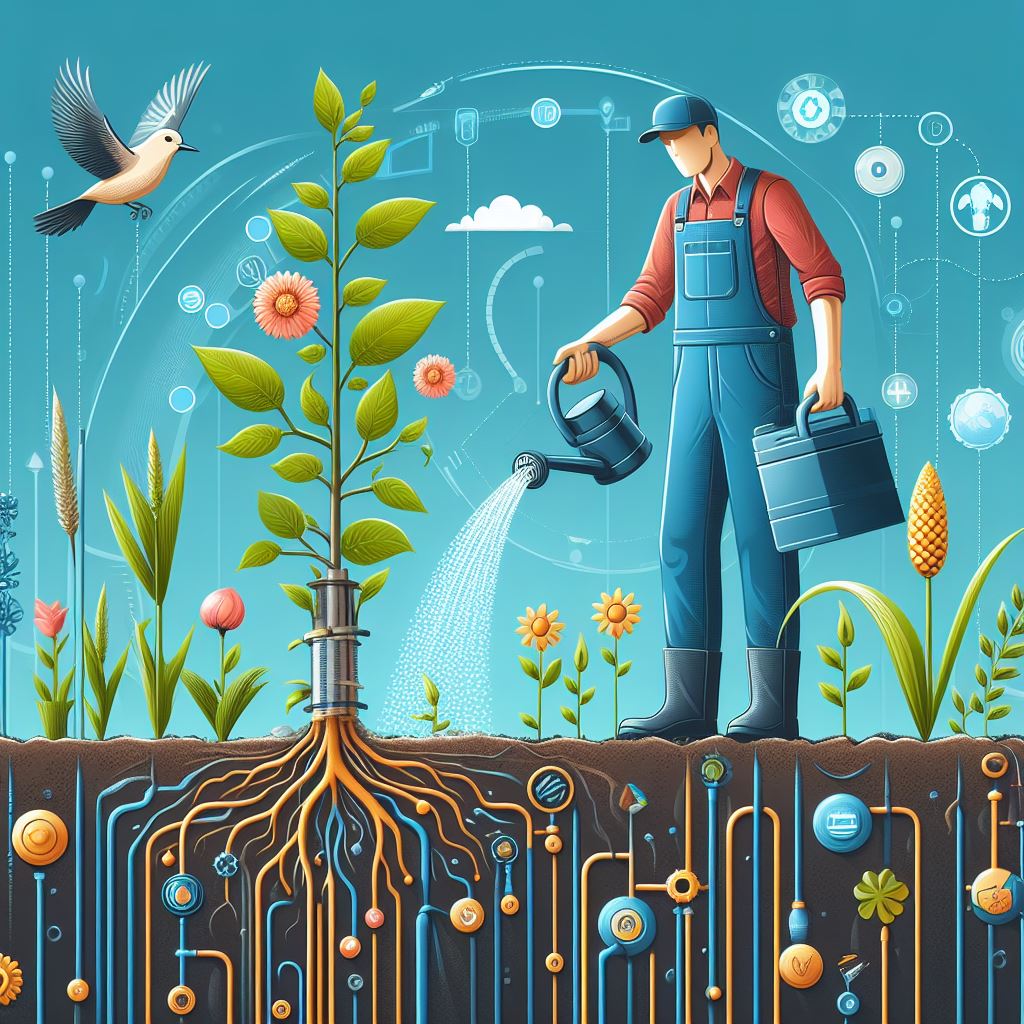Nitrogen is one of the most important nutrients for plants, as it helps them produce chlorophyll, amino acids, and proteins. Without enough nitrogen, plants can suffer from stunted growth, yellowing leaves, and poor fruit and flower production (How to Increase Nitrogen in Soil). However, many gardeners face the challenge of maintaining adequate nitrogen levels in their soil, as nitrogen can be easily lost through leaching, erosion, and crop removal.

Fortunately, there are many ways to increase nitrogen in soil naturally, using organic or inorganic materials that are readily available and affordable. In this blog post, we will share with you 30 effective methods to add nitrogen to your soil and improve your garden’s health and productivity. Whether you need a quick fix or a long-term solution, you will find something that suits your needs and preferences.
Before we dive into the methods, let’s briefly review why soil testing is essential for determining the nitrogen levels and pH of your soil, and how to do it correctly.
Why Soil Testing is Important
Soil testing is the first step to increasing nitrogen in soil, as it tells you how much nitrogen your soil already has, and whether it needs more or less. Soil testing also reveals the pH of your soil, which affects the availability of nitrogen and other nutrients to plants. Different plants have different pH preferences, and adding nitrogen can alter the pH of your soil, so you need to know the optimal range for your crops and how to adjust it if necessary.
To test your soil, you can use a soil test kit, make one yourself, or contact a nearby Extension Office to coordinate a test. You will need to collect soil samples from different parts of your garden, mix them together, and follow the instructions on the kit or the DIY method. You will get a reading of the nitrogen level (usually in parts per million or ppm) and the pH level (usually on a scale from 0 to 14, with 7 being neutral).
The ideal nitrogen level for most plants is between 50 and 100 ppm, but this can vary depending on the type and stage of the plant. The ideal pH level for most plants is between 6 and 7, but some plants prefer more acidic or alkaline soil. You can use a chart or a guide to find out the specific requirements of your plants.
Once you have the results of your soil test, you can decide which method of adding nitrogen to soil is best for you. Here are 30 options to choose from, divided into three categories: organic, inorganic, and beyond the basics.

Organic Methods of increase Nitrogen to Soil
Organic methods of adding nitrogen to soil involve using natural materials that contain or produce nitrogen, such as plant or animal waste, compost, or cover crops. These methods are environmentally friendly, as they recycle organic matter, improve soil quality, and reduce the need for synthetic fertilizers. However, they can also take longer to work, as they depend on the decomposition of the materials by soil microbes. Here are 10 organic methods of adding nitrogen to soil that you can try:
- Compost: Compost is one of the best organic sources of nitrogen, as it contains a variety of plant and animal materials that release nitrogen as they break down. Compost also adds organic matter, improves soil structure, and increases water retention. You can make your own compost by piling up kitchen scraps, yard waste, and aged manure, and turning it regularly to speed up the decomposition. Alternatively, you can buy ready-made compost from a garden center or a local farmer. You can apply compost to your soil as a top dressing, a side dressing, or a soil amendment, depending on your needs and preferences.
- Cover Crops: Cover crops are plants that you grow between seasons or between rows of your main crops, to protect and enrich the soil. Some cover crops, such as legumes (beans, peas, clover, etc.), are nitrogen-fixers, meaning that they have a symbiotic relationship with bacteria that convert atmospheric nitrogen into plant-available nitrogen. When you plant cover crops, they capture nitrogen from the air and store it in their roots and nodules. When you harvest or mow them, they leave behind nitrogen-rich residues that decompose and release nitrogen into the soil. You can also till them under while they are still green, to create a green manure that adds a quick burst of nitrogen to the soil.
- Coffee Grounds: Coffee grounds are a popular and easy way to add nitrogen to soil, as they are readily available and have a high nitrogen content. Coffee grounds also improve soil drainage, attract earthworms, and lower the pH of the soil, which can benefit acid-loving plants like blueberries and tomatoes. You can collect used coffee grounds from your own coffee maker, or ask for them from a local coffee shop. You can sprinkle them directly on the soil surface, or mix them with compost or other organic materials. However, be careful not to overdo it, as too much coffee grounds can cause nitrogen deficiency in plants, as the microbes that break down the grounds use up some of the nitrogen in the process.
- Tea Bags: Tea bags are another easy and cheap way to add nitrogen to soil, as they contain tannins and other compounds that have a nitrogen content. Tea bags also lower the pH of the soil, which can benefit acid-loving plants. You can use any kind of tea, but black tea is especially rich in nitrogen. You can compost the tea bags first, or tear them open and scatter them on the soil surface. You can also brew a weak tea with the used tea bags, and use it as a liquid fertilizer for your plants.
- Blood Meal: Blood meal is a by-product of the slaughterhouse industry, made from dried and powdered animal blood. It is a very high-nitrogen fertilizer, with a typical NPK ratio of 12-0-0. Blood meal can provide a fast and powerful boost of nitrogen to your plants, especially leafy greens and flowers. However, it can also burn your plants if used too much or too often, so you need to follow the instructions carefully and use it sparingly. You can apply blood meal to your soil as a top dressing, a side dressing, or a soil amendment, depending on your needs and preferences. You can also mix it with water and use it as a liquid fertilizer, but be careful not to splash it on the foliage, as it can stain and damage the leaves.
- Feather Meal: Feather meal is another by-product of the slaughterhouse industry, made from ground and sterilized poultry feathers. It is a high-nitrogen fertilizer, with a typical NPK ratio of 13-0-0. Feather meal can provide a steady and long-lasting supply of nitrogen to your plants, as it decomposes slowly and releases nitrogen gradually. However, it can also attract rodents and other pests, so you need to compost it first or bury it deep into the soil. You can apply feather meal to your soil as a top dressing, a side dressing, or a soil amendment, depending on your needs and preferences.
- Hair Clippings: Hair clippings are a simple and free way to add nitrogen to soil, as they contain keratin, a protein that has a high nitrogen content. Hair clippings also add organic matter, improve soil structure, and retain moisture. You can collect hair clippings from your own hair, your pets, or your local barber or salon. You can compost the hair clippings first, or mix them with other organic materials. You can also sprinkle them directly on the soil surface, or dig them into the soil. However, be aware that hair clippings can take a long time to decompose, and may temporarily reduce the nitrogen availability in the soil, as the microbes that break down the hair use up some of the nitrogen in the process.
- Fish Emulsion: Fish emulsion is a liquid fertilizer made from processed fish waste. It is a high-nitrogen fertilizer, with a typical NPK ratio of 5-1-1. Fish emulsion can provide a quick and easy boost of nitrogen to your plants, especially during the growing season. However, it can also have a strong and unpleasant odor, so you need to use it sparingly and avoid applying it on windy days or near your house. You can dilute fish emulsion with water and use it as a foliar spray or a soil drench, depending on your needs and preferences. You can also make your own fish emulsion by fermenting fish scraps with water, molasses, and an inoculant, such as effective microorganisms (EM) or lactobacillus.
Inorganic Methods of Increase Nitrogen in Soil
Inorganic methods of adding nitrogen to soil involve using synthetic or mineral-based fertilizers that contain or produce nitrogen, such as ammonium sulfate, urea, or potassium nitrate. These methods are fast and effective, as they provide readily available nitrogen to plants. However, they can also have some drawbacks, such as leaching, runoff, pollution, soil acidification, and salt buildup. Therefore, you need to use them wisely and sparingly, and follow the instructions carefully. Here are four inorganic methods of adding nitrogen to soil that you can try:
9. Commercial Nitrogen Fertilizer
One of the easiest and most convenient ways to add nitrogen to soil is to use a commercial nitrogen fertilizer. These are products that contain nitrogen in various forms, such as nitrate, ammonium, or urea. You can find them in granular, liquid, or slow-release forms, depending on how quickly you want the nitrogen to be available to the plants.
The advantage of using a commercial nitrogen fertilizer is that you can control the amount and timing of nitrogen application, and you can choose a product that suits your soil and plant types. For example, if you have sandy soil that drains quickly, you may want to use a slow-release fertilizer that provides a steady supply of nitrogen over time. If you have clay soil that holds water and nutrients, you may want to use a granular or liquid fertilizer that dissolves quickly and does not cause salt buildup.
The disadvantage of using a commercial nitrogen fertilizer is that it can be expensive, harmful to the environment, and detrimental to the soil health. Overuse of nitrogen fertilizer can lead to nutrient runoff, water pollution, and greenhouse gas emissions. It can also disrupt the natural balance of soil microbes, reduce the organic matter content, and increase the soil acidity. Therefore, it is important to use a commercial nitrogen fertilizer sparingly and follow the label instructions carefully. Remember, less is often more!
10. Ammonium Sulfate
Another way to add nitrogen to soil is to use ammonium sulfate, which is a fast-acting fertilizer that delivers readily available nitrogen to the plants. Ammonium sulfate is a salt that contains 21% nitrogen and 24% sulfur. It is usually applied as a granular or powdered product that dissolves in water and releases ammonium and sulfate ions into the soil.
The advantage of using ammonium sulfate is that it provides a quick boost of nitrogen to the plants, especially in cold or alkaline soils where other forms of nitrogen may be less effective. It also supplies sulfur, which is another essential nutrient for plants. Sulfur helps plants produce enzymes, amino acids, and vitamins, and it enhances the flavor and quality of some crops, such as onions, garlic, and brassicas.
The disadvantage of using ammonium sulfate is that it can lower the soil pH and increase the soil acidity. This can affect the availability of other nutrients, such as phosphorus, calcium, and magnesium, and it can harm the soil microbes and organic matter. It can also cause salt buildup and damage the plant roots if applied too frequently or in high doses. Therefore, it is important to use ammonium sulfate sparingly and monitor the soil pH regularly. You may need to add lime or other amendments to neutralize the soil acidity.
11. Urea
Urea is another fast-acting fertilizer that can add nitrogen to soil. Urea is an organic compound that contains 46% nitrogen and is produced synthetically or naturally by animals. It is usually applied as a granular, prilled, or coated product that breaks down in water and releases urea molecules into the soil.
The advantage of using urea is that it provides a high amount of nitrogen to the plants in a relatively cheap and easy way. It is also less likely to cause salt buildup or leaching than other forms of nitrogen, as it is converted to ammonium and nitrate by soil microbes before plants can use it.
The disadvantage of using urea is that it needs conversion by soil microbes before plants can use it, which can take time and depend on the soil temperature, moisture, and pH. If the conversion is too slow or incomplete, urea can be lost to the atmosphere as ammonia gas, which can reduce the nitrogen efficiency and cause air pollution. It can also increase the soil pH and alkalinity, which can affect the availability of other nutrients and the soil health. Therefore, it is important to use urea carefully and incorporate it into the soil as soon as possible after application.
12. Potassium Nitrate
Potassium nitrate is a fertilizer that provides both nitrogen and potassium to the soil. Potassium nitrate is a salt that contains 13% nitrogen and 44% potassium. It is usually applied as a granular, crystalline, or soluble product that dissolves in water and releases nitrate and potassium ions into the soil.
The advantage of using potassium nitrate is that it supplies two essential nutrients to the plants in one product. Nitrogen helps plants grow and produce chlorophyll, while potassium helps plants regulate water, strengthen cell walls, and resist diseases and stresses. Potassium nitrate is especially beneficial for crops that have high potassium requirements, such as fruits, vegetables, and flowers.
The disadvantage of using potassium nitrate is that it can be expensive, and it can cause potassium toxicity or imbalance in some plants. Some plants are sensitive to high levels of potassium, such as tomatoes, peppers, and beans, and they may show symptoms such as leaf scorch, reduced fruit size, and poor quality. It can also affect the uptake of other nutrients, such as calcium, magnesium, and iron, and it can reduce the soil acidity. Therefore, it is important to use potassium nitrate moderately and according to the plant and soil needs.
13. Crop Rotation
Crop rotation is a natural and sustainable way to add nitrogen to soil. Crop rotation is the practice of growing different crops in the same area in a sequential order, usually over a period of several years. Crop rotation can improve the soil fertility, structure, and health, as well as prevent pest and disease problems.
The advantage of using crop rotation is that it can increase the nitrogen in soil by planting certain crops that can fix atmospheric nitrogen and convert it into a form that plants can use. These crops are called legumes, and they include beans, peas, clover, alfalfa, and soybeans. Legumes have a symbiotic relationship with bacteria called rhizobia, which live in their root nodules and capture nitrogen from the air. The legumes provide the bacteria with carbohydrates, and the bacteria provide the legumes with nitrogen. Some of the nitrogen is used by the legumes, and some of it is released into the soil when the legumes die or are harvested.
The disadvantage of using crop rotation is that it requires planning, time, and space. You need to know the nitrogen requirements and benefits of different crops, and you need to arrange them in a suitable order and duration. You also need to have enough land to rotate the crops, and you may need to sacrifice some yield or quality for some crops. Therefore, it is important to use crop rotation wisely and adapt it to your specific conditions and goals.
- Soil Testing (Continued): You can collect soil samples from different parts of your garden, mix them together, and follow the instructions on the kit or the DIY method. You will get a reading of the nitrogen level (usually in parts per million or ppm) and the pH level (usually on a scale from 0 to 14, with 7 being neutral). The ideal nitrogen level for most plants is between 50 and 100 ppm, but this can vary depending on the type and stage of the plant. The ideal pH level for most plants is between 6 and 7, but some plants prefer more acidic or alkaline soil. You can use a chart or a guide to find out the specific requirements of your plants. Once you have the results of your soil test, you can decide which method of adding nitrogen to soil is best for you.
- Tillage: Tillage is the practice of loosening and turning over the soil, to improve the soil structure, aeration, and drainage. Tillage can help increase nitrogen in soil, as it exposes the organic matter and the soil microbes to oxygen, which stimulates the decomposition and the nitrogen cycle. Tillage can also help incorporate the nitrogen-rich materials, such as compost or manure, into the soil. However, tillage can also have some drawbacks, such as disturbing the soil life, increasing the soil erosion, and releasing the carbon dioxide and the nitrous oxide into the atmosphere. Therefore, you need to minimize tillage or use alternative methods, such as no-till or reduced tillage, which rely on the natural processes and the tools, such as mulch or cover crops, to improve the soil quality and fertility.
- Watering: Watering is the practice of supplying water to the plants and the soil, to maintain the optimal moisture level for growth and development. Watering can help increase nitrogen in soil, as it dissolves the nitrogen and transports it to the plant roots. Watering can also help leach the excess salts and the toxins from the soil, and prevent the nitrogen deficiency caused by the drought stress. However, watering can also have some drawbacks, such as leaching the nitrogen and the other nutrients from the soil, causing the runoff and the pollution, and creating the waterlogging and the anaerobic conditions. Therefore, you need to water wisely and sparingly, and follow the best practices, such as watering deeply and infrequently, using drip irrigation or soaker hoses, mulching the soil surface, and collecting the rainwater.
- Mulching: Mulching is the practice of covering the soil surface with a layer of organic or inorganic materials, such as straw, leaves, wood chips, plastic, or gravel. Mulching can help increase nitrogen in soil, as it reduces the evaporation and the runoff, conserves the soil moisture, suppresses the weeds, and moderates the soil temperature. Mulching can also help add nitrogen to soil, as the organic mulch decomposes slowly and releases nitrogen over time. However, mulching can also have some drawbacks, such as attracting the pests and the diseases, interfering with the seed germination, and creating the nitrogen deficiency if the mulch is too thick or too fresh. Therefore, you need to mulch carefully and appropriately, and follow the best practices, such as choosing the right mulch for your plants and your soil, applying the mulch at the right time and the right amount, and replenishing the mulch as needed.
- Earthworms: Earthworms are beneficial soil organisms that feed on the organic matter and the soil particles, and produce the castings that are rich in nitrogen and other nutrients. Earthworms can help increase nitrogen in soil, as they aerate the soil, improve the soil structure and drainage, and enhance the nutrient cycling and availability. Earthworms can also help increase the diversity and the activity of the soil microbes, which are responsible for the nitrogen cycle in the soil. You can attract earthworms to your soil by providing them with organic matter, moisture, and pH-neutral conditions. You can also buy earthworms from a garden center or a local farmer, and introduce them to your soil. However, be aware that not all earthworms are native or beneficial to your soil, and some may be invasive or harmful. Therefore, you need to identify the earthworms that are suitable for your soil and your plants, and avoid introducing the exotic or the unwanted species.
- Leguminous Mulch: Leguminous mulch is a type of organic mulch that is made from the shredded leaves of the nitrogen-fixing trees, such as locust, alder, or acacia. Leguminous mulch can help increase nitrogen in soil, as it contains a high percentage of nitrogen that is slowly released as the mulch decomposes. Leguminous mulch can also help improve the soil quality, as it adds organic matter, conserves soil moisture, suppresses weeds, and moderates soil temperature. You can make your own leguminous mulch by collecting and shredding the fallen leaves of the nitrogen-fixing trees, or buy ready-made leguminous mulch from a garden center or a local farmer. You can apply leguminous mulch to your soil as a top dressing, a side dressing, or a soil amendment, depending on your needs and preferences.
- Coffee Cake: Coffee cake is a method of layering the used coffee grounds and the nitrogen-rich materials, such as compost or manure, in your garden beds, to create a slow-release, layered effect. Coffee cake can help increase nitrogen in soil, as it provides a steady and gradual supply of nitrogen to your plants, as the layers decompose and release nitrogen over time. Coffee cake can also help improve the soil quality, as it adds organic matter, improves soil drainage, lowers soil pH, and attracts earthworms. You can make your own coffee cake by collecting the used coffee grounds from your own coffee maker, or asking for them from a local coffee shop. You can also use the coffee grounds that are mixed with other organic materials, such as eggshells or tea bags. You can apply coffee cake to your soil by digging a trench or a hole in your garden bed, filling it with alternating layers of coffee grounds and nitrogen-rich materials, and covering it with soil. You can also spread coffee cake on the soil surface, and cover it with mulch. However, be careful not to use too much coffee cake, as it can cause nitrogen deficiency in plants, as the microbes that break down the coffee grounds use up some of the nitrogen in the process.
Bonus Boosters:
- Urine Power (Diluted!): Diluted human urine (yes, you read that right!) can be a surprising source of nitrogen, but research and use responsibly.
- Manure Tea Magic: Steep aged manure in water to create a nitrogen-rich “tea” for your plants. Dilute well before use.
- Aquarium Water Wonder: Use aged aquarium water (free of chemicals) to add a nitrogen boost, especially beneficial for potted plants.
- Lightning Strikes (Literally): Lightning actually fixes atmospheric nitrogen into the soil, so a good thunderstorm can be a natural nitrogen boost!
Remember:
- Match your methods to your plants’ needs. Different plants have different nitrogen requirements.
- Start small and monitor your plants. Too much nitrogen can be harmful.
- Organic methods take time but are sustainable. Be patient and enjoy the journey!
- Consult your local expert. They can provide specific advice for your soil and climate.
leave your questions in comments sections and bookmark/follow our website for more updates





